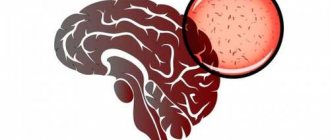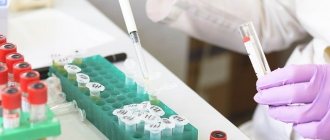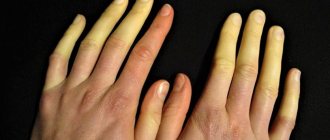Meningitis is almost always accompanied by high body temperature, which can reach 42 0 C. But in some cases, the disease can occur without fever, even purulent meningitis can have a smooth course and not manifest itself as an increase in body temperature. This condition is dangerous to the health and life of the patient. The symptoms of meningitis are similar to the symptoms of ARVI and other colds; the absence of fever and meningeal symptoms often causes an incorrect diagnosis.
Effective diagnosis of the disease depends on the experience of doctors and the availability of modern equipment at the clinic. The Yusupov Hospital is equipped with innovative equipment from leading manufacturers in the world. At the hospital and partner clinics, you can undergo MRI, CT, and diagnose the condition of the brain and spinal cord, the presence of lesions, hydrocephalus and other pathological conditions. Highly qualified doctors at the hospital provide emergency care to patients around the clock.
Some facts
So what is meningitis? This disease is usually localized in the arachnoid and pia mater, without directly affecting the brain. It is found everywhere, but in third world countries the rates are almost half as high as in Europe. Until the beginning of the 20th century, the mortality rate from brain inflammation reached 92%, but antibodies against infectious agents obtained in 1906 made it possible to significantly reduce mortality.
Penicillin, invented almost forty years later, significantly alleviated the course of the disease and further reduced the number of deaths. At the beginning of the 21st century, it was proposed to use synthetic testosterone preparations to combat bacterial inflammation of the brain.
People of any age and gender can get meningitis. The disease makes no exceptions for anyone. Those at risk include people with poor health, HIV-infected people and premature babies. Most often, pathology is recorded between October and April. This is greatly facilitated by fluctuations in ambient temperature, vitamin deficiency, walking without a headdress, and large crowding of people indoors.
Classification of the disease
There are many different forms of brain inflammation. All types of meningitis today are systematized and divided into groups according to characteristics.
According to the conditions of occurrence, they distinguish:
- viral inflammation of the brain;
- infectious meningitis (bacterial);
- fungal meningitis;
- mixed infection;
- protozoal and nonspecific inflammation of the brain.
According to the nature of the process, there are purulent (meningococcal, staphylococcal meningitis) and aseptic meningitis (serous). The purulent form can be primary or secondary.
Types of meningitis
You can get sick both from direct penetration of the pathogen into the brain, and as a result of complications of an infectious disease.
Bibliography
- Berezov T.T. Biological chemistry / T.T. Berezov, V.F. Korovkin. -M.: Medicine, 2008. 704 p.
- Vlasov V.V. Efficiency of diagnostic studies. M.: Medicine, 1988. - 189 p.
- Ivanov K.S. Meningococcal infection in young people: Clinic, diagnosis, treatment: abstract. dis. . Dr. med. Sciences / K.S. Ivanov. -L., 1982.-30 p.
- Lobzin Yu.V. Meningococcal infection / Yu.V. Lobzin, K.S. Ivanov / Selected issues in the therapy of infectious patients / edited by. ed. Yu.V. Lobzin. St. Petersburg: FOLIANT Publishing House LLC, 2005. - pp. 302-322.
- Mankov M.V. Pathomorphogenesis of purulent bacterial meningitis in children / M.V. Mankov, PA Nasyrov // Epidemiology and infectious diseases. 2005. - No. 3. — P. 59-61.
- Platonov A.E. Relationship between the severity of meningococcal infection and the levels of endotoxin and complement in the blood of patients / A.E. Platonov, D.V. Troshchansky, V.B. Beloborodov et al. // Clinical. medicine. - 1999. - No. 2. - P. 32-37.
- Yushchuk N.D. Lectures on infectious diseases / N.D. Yushchuk, Yu.Ya. Vengerov // Meningococcal infection. M.: Medicine, 2007. - P.466-480.
Why does brain inflammation develop?
What causes meningitis? The causes of the disease are very diverse. The main ones are bacteria, fungi and viruses. This route of infection is inherent in all primary pathologies.
The secondary form of meningitis usually develops as a complication of other infectious diseases. The source of inflammation can be the ear, sinuses, lightly infected wounds and injuries due to fractures, teeth, bone tissue with osteomyelitis.
For example, otitis media is often the cause of otogenic meningitis. Inflammation of the middle ear develops against the background of a staphylococcal or streptococcal infection. Therefore, otogenic meningitis, as a rule, is streptococcal or staphylococcal. The pathogen can enter the membranes of the brain both in the acute phase of the disease and in the chronic phase. This happens with the blood flow, through the labyrinth of the ear or when bone tissue is destroyed.
In addition to inflammation of the hearing organs, there are other causes of meningitis:
- Osteomyelitis. The infection enters the brain through the bloodstream or through contact when bones are destroyed, for example, with osteomyelitis of the jaw.
- Pulmonary tuberculosis. Pneumonia is considered the main cause of tuberculous meningitis.
- Sinusitis. In most cases, sinus inflammation is caused by a virus. Such sinusitis itself rarely causes the disease, but if it is accompanied by a bacterial infection, this may well provoke the disease.
In childhood and adolescence, rheumatic meningoencephalitis is most often recorded, which affects not only the membrane, but also the brain itself. This pathology develops against the background of a rheumatic attack and is always accompanied by a hemorrhagic rash.
Often the disease develops at the middle or final stage of the initial infection. For example, borreliosis inflammation of the brain manifests itself at stage II of Lyme borreliosis. Syphilitic damage to the membranes is observed during the transition of syphilis to phase 2 or 3, when the pathogen reaches the central nervous system.
Meningitis can occur after various surgical interventions. The infection easily enters the body through wounds and medical instruments.
Fungal (candida) inflammation of the brain is often observed in people with weakened immune systems or as a result of prolonged antibiotic therapy. People with HIV infection are most susceptible to this form of pathology.
Routes of infection
Let's look at how meningitis is transmitted. Since the meningococcal form of inflammation is more common in medical practice, we will find out in what ways you can become infected with staphylococcus.
Routes of transmission
The infection spreads in many ways, but most often it is transmitted through airborne droplets when a sick person coughs and sneezes. During the cold period, there is a sharp rise in morbidity associated with low air temperatures and large crowding of people in enclosed spaces.
In addition, there are other factors under the influence of which meningitis can be transmitted:
- contact method (handshake, kisses, door handles and handrails in transport);
- fecal-oral (dirty hands, insufficiently washed vegetables and fruits, greens);
- while swimming in infected bodies of water or drinking raw, contaminated water.
In addition to these methods, the disease is easily transmitted through blood and lymph. Often infection occurs during childbirth along the vertical route.
First symptoms of the disease
The incubation period of meningitis, in other words, the time from the moment the pathogen enters the human body until the first signs of pathology appear, has a different duration. The interval can vary from several hours to 10–12 days, sometimes more. This variation depends on the type of pathogenic agent, its concentration and method of penetration.
The time of appearance of the first symptoms depends on the type of pathogen
If the inflammation of the brain is caused by an aseptic form of meningitis, the first symptoms appear 10–12 days after infection. In this case, the picture of the disease is similar to the flu. If the inflammation is viral, the incubation time is reduced to 3–7 days. The longest period is observed in mumps (mumps) - up to 21 days, although it is often reduced to 15–18 days.
Pathology develops much faster with weak immunity or if a person is sick at the time of infection.
During the incubation period, the disease does not manifest itself in any way. The number of pathogenic agents is still so small that the body can easily cope with them. But gradually the concentration of pathogens increases, and the immune system is no longer able to defeat them. This is where the first signs of brain inflammation appear.
All this time, a person, as a rule, is not infectious to others, but in some cases the latent period is 2-3 days ahead of the incubation period. This happens with chickenpox and similar pathologies.
Does the temperature increase with meningitis?
Very often, patients suffering from meningitis mistake it for a simple migraine. Most of them do not even realize that they are developing a serious disease that poses a real threat to human health and life. But how to diagnose the inflammatory process in order to prevent serious consequences and what is the temperature for meningitis accompanied by a febrile state.
Types of pathological syndrome
Meningitis is an inflammation of the lining of the brain and spinal cord. Pathology in 50% of cases occurs in childhood, but despite this, an adult can also get sick.
Depending on the cause of the development of the inflammatory process, the following types of meningitis are distinguished:
- Infectious.
- Traumatic.
- Infectious-allergic: microbial and neuroviral (herpes, influenza, serous meningitis, tuberculosis).
- Fungal.
By location: panmeningitis, leptomeningitis, pachymeningitis. Meningitis is also divided into purulent and serous types, secondary (against the background of the underlying disease, the infection spreads to the membranes of the brain) and primary (the disease immediately affects the “gray matter”).
In almost all cases, meningitis occurs in an acute form, with the exception of the tuberculosis type of pathology; it can develop gradually over 2 weeks or several months.
According to the methods of infection, meningitis is classified as:
- perineural;
- hematogenous;
- contact;
- lymphogenous.
Meningeal symptoms - high intracranial pressure, observed with any type of inflammatory process, characterized by severe pain in the head, a feeling of “pressure” on the eyes, ears, a feeling of nausea and vomiting, a reaction to extraneous noise, photophobia, most often meningitis is accompanied by fever.
Causes of the pathological condition
People of all ages are susceptible to infections of viral origin, but most often children 5 years of age and older are infected with meningitis. The risk of developing an inflammatory process in infants is minimal; mother's milk protects against a dangerous illness.
Factors that can provoke the appearance of the disease:
- Enterovirus 71 subspecies.
- Visiting overcrowded kindergartens and schools.
- Poor quality of life.
- Chronic pathologies that occur in severe form.
- Lack of personal hygiene.
- Diseases of the nervous system.
- Back and skull injuries.
- Weakened immune system.
A viral type of meningitis occurs in a mild form and goes away on its own if it does not develop into encephalitis - inflammation of the brain.
Symptoms of the pathological syndrome
Meningitis can develop regardless of the time of year, but with the arrival of cold weather, along with flu and colds, cases of infection are observed more often. Signs of the syndrome can be different; timely diagnosis significantly increases the chance of a quick recovery without health consequences.
With inflammation of the membranes of the brain and spinal cord, there is most often an elevated temperature, indicating the occurrence of a pathological process, which can rise to significant limits. It is recommended to knock it down with the help of drugs recommended by your doctor.
The temperature during the inflammatory process can be as follows:
- febrile – 38-39 degrees;
- pyretic – 39-40 degrees;
- hyperpyretic temperature - up to 41 degrees.
Viral meningitis sometimes occurs without fever. The only symptoms are lethargy, increased irritability, poor food intake or refusal, and vomiting. In some cases, patients experience a decrease in temperature.
Additional symptoms of meningitis:
- Feeling of nausea and constant vomiting that does not relieve the painful condition.
- Attacks of dizziness, headaches.
- Impaired consciousness.
- Typical position for a dangerous illness: the head is pulled back, the lower limbs are bent, pulled towards the retracted abdomen.
- A small rash all over the body, observed after a rise in temperature.
- Redness of the tonsils and throat.
In the absence of adequate therapy, fainting, delirium, and convulsions are observed. After 2-3 days, the person falls into a coma, he experiences partial or general paralysis of the limbs and respiratory muscles, which can cause death.
The infection spreads throughout the body, accompanied by:
- low blood pressure;
- shortness of breath;
- rapid heartbeat;
- dark rash.
Saving a patient’s life with an advanced form of meningitis is quite difficult, but possible. Untimely diagnosis and therapy cause irreversible processes in the human body: the surviving patient becomes disabled.
Early consultation with a doctor and adequate treatment help eliminate the symptoms of meningitis in 2-3 weeks. Inflammation does not always occur with a high temperature; in case of severe headaches, which the patient has never complained of before, an urgent examination should be performed.
Signs of pathological syndrome in children
The clinical symptoms of meningitis are the same as in adult patients, but other manifestations of the inflammatory process are also characteristic of early age.
Signs of the disease may be as follows:
- Regurgitation of food.
- Stool disorder.
- Drowsiness, apathetic state.
- At high temperatures, the extremities remain cold.
- While sitting, the child throws back his head and leans forward.
- Tense chest and back muscles.
- Constant crying.
- Poor appetite.
- Swelling of the fontanelle.
The incubation period is short, meningitis develops quite quickly (sometimes up to 10 days). The symptoms of inflammation of the membranes of the brain and spinal cord can easily be confused with the flu. The weaker the immune system, the more severe the patient’s condition.
Methods for diagnosing the inflammatory process
The diagnosis can be made based on the results of a study of cerebrospinal fluid. If it is confirmed, then the composition of the fluid determines the type of meningitis - purulent or serous, and complex therapy is prescribed.
Diagnostics also includes other methods:
- study of the fundus;
- electroencephalography;
- X-ray of the skull;
- CT and MRI of the brain.
The diagnosis of a dangerous disease is made in the presence of several factors: signs of the virus, symptoms of meningitis, characteristic changes in the cerebrospinal fluid.
Reactive brain inflammation
An acute form of bacterial syndrome that develops at lightning speed. Purulent infections affecting the membranes of the “gray matter” cause a coma and death of the patient. The causes of the disease are meningococci, streptococci, pneumococci. The disease can manifest itself as a consequence of pneumonia or sinusitis.
The primary signs of meningitis are:
- High temperature, which is not knocked down by anything.
- Hardening in the neck and back of the head.
- Migraine attacks, sore throat.
- Constant vomiting.
Reactive meningitis can be fatal within 24 hours. In some cases, even correct diagnosis of the disease will not help to avoid negative consequences - aseptic shock.
Serous type inflammation
The cause of this type of disease is a serous inflammatory process that occurs in the membranes of the “gray matter”. Based on its origin, meningitis is divided into types such as:
- viral illness;
- bacterial meningitis: tuberculous, syphilitic;
- fungal.
The development of acute serous disease is influenced by viruses of various etiologies. The pathology is accompanied by high fever, which in many patients was brought down only by strong medications; simple antipyretics had no effect. The virus affects the central and peripheral nervous system.
Treatment of dangerous syndrome in adults and children
Meningitis is a serious pathological condition that requires emergency, adequate therapy. Patients with inflammation of the brain and spinal cord require urgent medical attention in a clinical setting. It is unacceptable to treat meningitis at home without the help of doctors, as this can cause the death of the patient.
The sooner you start therapy, the greater the likelihood of recovery. Treatment of the pathological syndrome includes taking antibiotics, which are the main method of complex treatment.
It is impossible to determine the type of pathogen using a blood test in 20% of situations. Usually, during the inflammatory process, medications are prescribed with an unknown cause for the manifestation of the pathological syndrome.
The drug is selected so as to cover the entire spectrum of the most common pathogens. The duration of treatment with antibiotics is 10 days or more; drugs must be taken for 7 days from the moment the temperature normalizes for infectious meningitis.
Possible complications after inflammation
Delayed treatment can lead to serious consequences. So, among the complications of a dangerous disease there are:
- Loss of vision (partial or complete).
- Strabismus.
- Paralysis of limbs.
- Bedsores.
- Delays in child development.
The best prevention of inflammation of the spinal cord and brain is strengthening the body's defenses: proper nutrition, hardening, personal hygiene. It is necessary to promptly treat viral and infectious pathologies, this will prevent the development of the disease.
The duration of therapy for the disease depends on its degree and form. With a late consultation with a neurologist, sometimes it is not possible to save a person’s life. Timely, adequate treatment is the key to a quick recovery, but recovery can take many years.
Whether meningitis occurs without fever can be determined by your doctor after a full examination. To prevent the inflammatory process, doctors prescribe special vaccines that are valid for 4 years. But the vaccine is not effective against some types of infection. You should carefully monitor the condition of your body and at the first dangerous symptom, contact your doctor.
Symptoms and signs of meningitis
How does meningitis manifest in adults? Signs of inflammation of the meninges resemble symptoms of an infectious disease. Among them, the most commonly observed are:
- fever;
- fatigue, loss of performance, drowsiness;
- photophobia and increased sensitivity to sounds;
- increased tone of the neck muscles;
- nausea and vomiting.
If the patient has very poor resistance, meningitis without fever often occurs. This suggests that the body is not able to fight the pathogenic agent and is not able to provide a protective response.
Brain inflammation is an extremely dangerous disease. It is very important not to miss the moment when the first signs of the disease develop. This will help you start treatment in a timely manner and avoid serious complications.
General symptoms of meningitis
Only the early manifestations of the disease are indicated here. In general, the symptoms of meningitis are very extensive and are divided into several groups, corresponding to one or another form of inflammation. You can read more about them here.
Test
First of all, the presence of meningitis can be determined in advance using special tests that you can perform even at home.
Because of the specific symptoms, they can immediately show whether a person is sick .
Kernig syndrome
A person is unable to straighten his legs bent at the knees. The patient is placed on his back and his leg is bent at the knee and hip joint at an angle of 90 degrees. If a person is sick with meningitis, he will not be able to straighten his legs after this.
Brundzinski syndrome
This syndrome has four symptoms. The first is that if you tilt your head forward, your legs involuntarily bend and pull towards your stomach. The second symptom is that if you press on the pubis, the legs bend at the knee and hip joints. The third symptom is that when one leg is bent, the other itself is pulled towards the stomach. Fourth - if you press on the cheek, your shoulders will rise and your arms will bend at the elbows.
These syndromes are observed in both adults and children with meningitis.
Diagnostics
To make an accurate diagnosis and identify the form of pathology, cerebrospinal fluid is taken from the lower parts of the spine. With different types of inflammation of the soft membrane of the brain, the fluid is noticeably different. With meningococcal and staphylococcal meningitis, it takes on the color of milk. A blood test detects low sugar and high protein.
Spinal puncture is the main diagnostic method
In addition to a spinal puncture, bacteriological culture is performed to determine the strain of the pathogen. In some cases, a computed tomography scan of the brain and x-ray are indicated.
Which analysis is critical?
The main method for diagnosing meningitis is cerebrospinal fluid analysis.
The latter is a fluid that circulates in the spinal cord and brain .
In its normal state, it should look like a transparent substance.
Liquor contains various chemical elements:
- hormones;
- organic and inorganic compounds;
- vitamins;
- substances responsible for the processing of blood.
Important! The main function of cerebrospinal fluid is considered to protect the brain from critical damage.
If we talk about the main symptom of meningitis, then it is headache. Often the harbinger of the disease is ARVI. In addition, star-shaped spots, increased drowsiness, general weakness and convulsions are recorded.
Useful video on the topic:
Treatment methods
Treatment of meningitis in adults is complex. It is mandatory to hospitalize the patient with bed rest. Drug therapy depends on the type of pathogen and includes:
- etiotropic treatment;
- immunostimulating therapy;
- symptomatic help.
- Below we will consider point by point how to treat meningitis and talk about the features of caring for the patient.
Hospitalization
The dangerous course of meningitis and the frequency of deaths require the patient to be in a hospital. The causative agents of brain inflammation are so numerous that each of them must be treated with its own group of drugs.
In a hospital, the patient is placed in an isolated room, protected from other patients, the intensity of light and noise is reduced, and if necessary, resuscitation is used.
Medications
The main function of drug therapy is to eliminate the pathogen. For this purpose, drugs of different groups are used.
Antibacterial agents
Antibiotics for meningitis are prescribed in case of microbial or purulent nature of the disease. Most often used:
- cephalosporins - Cefotaxime, Ceftazidime, Ceftriaxone;
- carbapenems - Doripenem, Meropenem, Meronem, Nerinam, Tsilaspen;
- penicillins - Ampicillin, Benzylpenicillin, Amoxiclav, Amoxicillin, Bicillin -1, -3, -5, Klamosar, Medoclav;
- amphenicols - Levomycetin.
In case of tuberculous form of the disease, the patient is prescribed Phthisoetam, Isoniazid, Phthisopyram, Streptomycin, Combutol. For greater effectiveness, the treatment regimen includes Pyrazinamide, Tizamide, and Rifampicin.
Using medications to eliminate the causative agent of infection
The therapeutic course should not exceed 12–14 days.
Antiviral drugs
Interferon and corticosteroids are usually prescribed to treat viral meningitis. In addition to them, nootropics, sedatives that have a hypnotic effect, and vitamin complexes are often prescribed.
The choice of antiviral drugs depends on the type of pathogen. In general, the fight against aseptic meningitis is based on symptomatic treatment and is similar to the treatment of respiratory diseases. The patient is prescribed analgesics, antipyretics, adsorbents, and drugs that reduce intracranial pressure.
Antifungal agents
The treatment regimen for the fungal form of meningitis is based on the use of Flucanazole, Amyclone, Amphocyl, Ancotil, Amphotericin B. In addition to the main treatment, symptomatic therapy is prescribed.
Detoxification
Symptoms of viral meningitis in children
To remove toxins from the body, adsorbent intestinal agents are used. The most popular:
- Enterosgel;
- Polysorb MP;
- Smecta;
- Enterodesis;
- Enterosorb.
In addition to adsorbents, plenty of fluids, vitamin complexes, herbal infusions, and fruit drinks are prescribed.
Symptomatic therapy
Such treatment is necessary to maintain the body and improve the patient’s condition. To eliminate or reduce the symptoms of meningitis, the following are prescribed:
- antihistamines - Zyrtec, Suprastin, Dramina, Zortac;
- antiemetics - Domperidone, Motilium, Zofran, Emetron;
- NSAIDs - Nurofen, Ibuprofen, Diclofenac;
- sedatives - Afobazole, Tenoten, Motherwort, Valerian;
- diuretics - Furosemide, Lasix, Furon, Diacarb;
- antipyretic and pain reliever - Acetaminophen.
Acetaminophen has anti-inflammatory, antipyretic and analgesic effects
To improve cerebrospinal fluid parameters, Cerebronorm or Cytoflavin are prescribed. To increase plasma pressure and reduce intracranial pressure, a 20% mannitol solution is administered intravenously to the patient.
Anticonvulsants
Inflammation of the brain is often accompanied by anxiety, overexcitement and seizures. In this case, the patient is recommended to take Phenobarbital, Aminazine, Diazepam.
In the hospital, the patient must undergo oxygen therapy. This is a fairly effective method that helps eliminate oxygen starvation of the brain and improve a person’s condition. The procedure is carried out through intubation or using an oxygen mask.
Patient care
Patients who have had inflammation of the brain require careful treatment and special care. From the moment of recovery, a clear daily routine should be established for them, a balanced diet should be introduced, and physical and mental stress should be limited.
The diet should be fractional and fully provide the patient with the necessary substances. It is better to remove animal fats from the diet, as they can provoke acidosis. It is recommended to drink more, at least 2 liters of clean water per day.
If 4 months after discharge the signs of the disease do not disappear, chronic meningitis develops and the patient is referred to determine the disability group.
Preventing brain inflammation
There are a number of preventive measures that can protect against meningitis. They are specific and non-specific.
Specific prevention
This type of preventive measures is based on vaccination of the population. The meningitis vaccine helps prevent viral and bacterial infections of the brain.
The main measure to prevent meningitis is vaccination.
After vaccination, people often experience various adverse reactions:
- weakness;
- temperature rise to 37.2–37.5 °C;
- redness and swelling at the injection site.
Usually after 1-2 days all ailments disappear. In rare cases, an allergic reaction to the meningitis vaccine is possible. It is manifested by tachycardia, severe swelling at the injection site, and high fever. If such symptoms appear, you should visit your doctor and tell him about the date of vaccination and the type of vaccine.
Other methods of prevention
There are other options for preventing meningitis. This is the so-called nonspecific prevention. It includes actions aimed at strengthening the immune system and eliminating possible contacts with carriers of the pathogen.
Strengthening the immune system
Hardening, prolonged exposure to fresh air, and winter sports help increase the body's resistance.
Good immunity helps avoid infection
Water procedures are very useful: rubbing or dousing with cold water, visiting the pool. The sun, especially the southern one, helps a lot. It stimulates the production of vitamin D, and in combination with fresh air it gives a powerful healing effect.
Balanced diet
Another important factor in preventing meningitis is a healthy diet. To have the ability to resist all kinds of viruses and bacteria, the body must sufficiently receive all the nutrients and vitamins it needs.
The immune system is extremely negatively affected by problems with the gastrointestinal tract. To balance the microflora, it is recommended to eat fermented milk dishes daily: kefir, natural yogurt, fermented baked milk.
In addition to food, vitamin complexes must be taken to replenish missing substances.
Hygiene rules
Prevention of meningitis includes certain precautions:
- Do not drink contaminated water or use it for cooking;
- It is recommended to wash vegetables and fruits well;
- You should not use the personal belongings of a stranger;
- during epidemics, in crowded places, it is advisable to wear a gauze bandage;
- When you come home from the street, you need to wash your hands well.
Ticks are often carriers of meningitis. Therefore, when going into the forest, you should be properly equipped and treat your clothes with acaricides. If a parasite is detected, it must be removed as quickly as possible and sent for analysis.
Prevention
The basic rule is mandatory vaccination. It should be done both at an early and adult age. It is also important to carry out parallel routine vaccination against other infectious pathologies (measles). Other preventative measures include:
- avoiding any contact with a person who has meningitis;
- if contact has taken place, it is important to take special preventive medications;
- during outbreaks of infection (acute respiratory infections, influenza), wear a protective mask;
- wash your hands regularly;
- Avoid eating unwashed vegetables and fruits and do not drink raw water.
What kind of disease is meningitis? This is a dangerous disease that, in the absence of proper and timely assistance, leads to dire consequences. Don't neglect your health and get regular vaccinations. When you notice the first symptoms, do not delay going to the doctor for an accurate diagnosis. You also received an answer to the question: “Is it an infectious disease or not?”
Consequences of meningitis
According to statistics, more than half of patients who have overcome the disease do not feel healthy for many years. People complain of memory problems, headaches, and spontaneous seizures. If the disease develops into chronic meningitis, loss of ability to work and assignment of disability are possible.
However, it must be said that in recent years such terrible complications are happening less and less often. Modern medicine can effectively combat brain inflammation. The main thing is to notice the first signs of the disease at an early stage and immediately contact a specialist.










